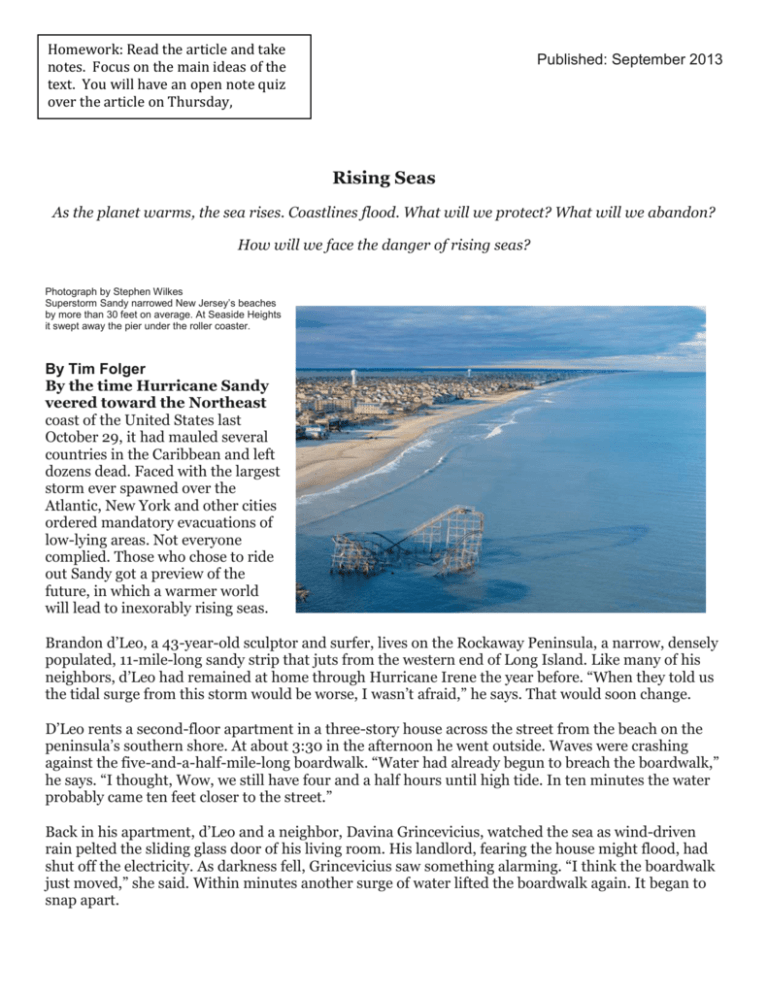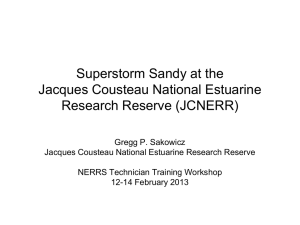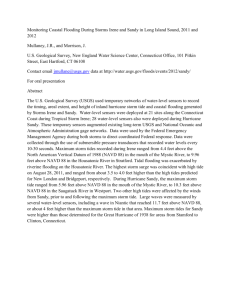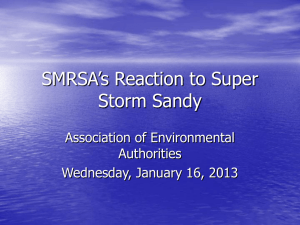How will we face the danger of rising seas?
advertisement

Homework: Read the article and take notes. Focus on the main ideas of the text. You will have an open note quiz over the article on Thursday, September 26th Published: September 2013 Rising Seas As the planet warms, the sea rises. Coastlines flood. What will we protect? What will we abandon? How will we face the danger of rising seas? Photograph by Stephen Wilkes Superstorm Sandy narrowed New Jersey’s beaches by more than 30 feet on average. At Seaside Heights it swept away the pier under the roller coaster. By Tim Folger By the time Hurricane Sandy veered toward the Northeast coast of the United States last October 29, it had mauled several countries in the Caribbean and left dozens dead. Faced with the largest storm ever spawned over the Atlantic, New York and other cities ordered mandatory evacuations of low-lying areas. Not everyone complied. Those who chose to ride out Sandy got a preview of the future, in which a warmer world will lead to inexorably rising seas. Brandon d’Leo, a 43-year-old sculptor and surfer, lives on the Rockaway Peninsula, a narrow, densely populated, 11-mile-long sandy strip that juts from the western end of Long Island. Like many of his neighbors, d’Leo had remained at home through Hurricane Irene the year before. “When they told us the tidal surge from this storm would be worse, I wasn’t afraid,” he says. That would soon change. D’Leo rents a second-floor apartment in a three-story house across the street from the beach on the peninsula’s southern shore. At about 3:30 in the afternoon he went outside. Waves were crashing against the five-and-a-half-mile-long boardwalk. “Water had already begun to breach the boardwalk,” he says. “I thought, Wow, we still have four and a half hours until high tide. In ten minutes the water probably came ten feet closer to the street.” Back in his apartment, d’Leo and a neighbor, Davina Grincevicius, watched the sea as wind-driven rain pelted the sliding glass door of his living room. His landlord, fearing the house might flood, had shut off the electricity. As darkness fell, Grincevicius saw something alarming. “I think the boardwalk just moved,” she said. Within minutes another surge of water lifted the boardwalk again. It began to snap apart. Three large sections of the boardwalk smashed against two pine trees in front of d’Leo’s apartment. The street had become a four-foot-deep river, as wave after wave poured water onto the peninsula. Cars began to float in the churning water, their wailing alarms adding to the cacophony of wind, rushing water, and cracking wood. A bobbing red Mini Cooper, its headlights flashing, became wedged against one of the pine trees in the front yard. To the west the sky lit up with what looked like fireworks—electrical transformers were exploding in Breezy Point, a neighborhood near the tip of the peninsula. More than one hundred homes there burned to the ground that night. The trees in the front yard saved d’Leo’s house, and maybe the lives of everyone inside—d’Leo, Grincevicius, and two elderly women who lived in an apartment downstairs. “There was no option to get out,” d’Leo says. “I have six surfboards in my apartment, and I was thinking, if anything comes through the wall, I’ll try to get everyone on those boards and try to get up the block. But if we’d had to get in that water, it wouldn’t have been good.” After a fitful night’s sleep d’Leo went outside shortly before sunrise. The water had receded, but thighdeep pools still filled parts of some streets. “Everything was covered with sand,” he says. “It looked like another planet.” A profoundly altered planet is what our fossil-fuel-driven civilization is creating, a planet where Sandy-scale flooding will become more common and more destructive for the world’s coastal cities. By releasing carbon dioxide and other heat-trapping gases into the atmosphere, we have warmed the Earth by more than a full degree Fahrenheit over the past century and raised sea level by about eight inches. Even if we stopped burning all fossil fuels tomorrow, the existing greenhouse gases would continue to warm the Earth for centuries. We have irreversibly committed future generations to a hotter world and rising seas. In May the concentration of carbon dioxide in the atmosphere reached 400 parts per million, the highest since three million years ago. Sea levels then may have been as much as 65 feet above today’s; the Northern Hemisphere was largely ice free year-round. It would take centuries for the oceans to reach such catastrophic heights again, and much depends on whether we manage to limit future greenhouse gas emissions. In the short term scientists are still uncertain about how fast and how high seas will rise. Estimates have repeatedly been too conservative. Global warming affects sea level in two ways. About a third of its current rise comes from thermal expansion—from the fact that water grows in volume as it warms. The rest comes from the melting of ice on land. So far it’s been mostly mountain glaciers, but the big concern for the future is the giant ice sheets in Greenland and Antarctica. Six years ago the Intergovernmental Panel on Climate Change (IPCC) issued a report predicting a maximum of 23 inches of sea-level rise by the end of this century. But that report intentionally omitted the possibility that the ice sheets might flow more rapidly into the sea, on the grounds that the physics of that process was poorly understood. As the IPCC prepares to issue a new report this fall, in which the sea-level forecast is expected to be slightly higher, gaps in ice-sheet science remain. But climate scientists now estimate that Greenland and Antarctica combined have lost on average about 50 cubic miles of ice each year since 1992— roughly 200 billion metric tons of ice annually. Many think sea level will be at least three feet higher than today by 2100. Even that figure might be too low. “In the last several years we’ve observed accelerated melting of the ice sheets in Greenland and West Antarctica,” says Radley Horton, a research scientist at Columbia University’s Earth Institute in New York City. “The concern is that if the acceleration continues, by the time we get to the end of the 21st century, we could see sea-level rise of as much as six feet globally instead of two to three feet.” Last year an expert panel convened by the National Oceanic and Atmospheric Administration adopted 6.6 feet (two meters) as its highest of four scenarios for 2100. The U.S. Army Corps of Engineers recommends that planners consider a high scenario of five feet. One of the biggest wild cards in all sea-level-rise scenarios is the massive Thwaites Glacier in West Antarctica. Four years ago NASA sponsored a series of flights over the region that used icepenetrating radar to map the seafloor topography. The flights revealed that a 2,000-foot-high undersea ridge holds the Thwaites Glacier in place, slowing its slide into the sea. A rising sea could allow more water to seep between ridge and glacier and eventually unmoor it. But no one knows when or if that will happen. “That’s one place I’m really nervous about,” says Richard Alley, a glaciologist at Penn State University and an author of the last IPCC report. “It involves the physics of ice fracture that we really don’t understand.” If the Thwaites Glacier breaks free from its rocky berth, that would liberate enough ice to raise sea level by three meters—nearly ten feet. “The odds are in our favor that it won’t put three meters in the ocean in the next century,” says Alley. “But we can’t absolutely guarantee that. There’s at least some chance that something very nasty will happen.” Even in the absence of something very nasty, coastal cities face a twofold threat: Inexorably rising oceans will gradually inundate low-lying areas, and higher seas will extend the ruinous reach of storm surges. The threat will never go away; it will only worsen. By the end of the century a hundred-year storm surge like Sandy’s might occur every decade or less. Using a conservative prediction of a half meter (20 inches) of sea-level rise, the Organisation for Economic Co-operation and Development estimates that by 2070, 150 million people in the world’s large port cities will be at risk from coastal flooding, along with $35 trillion worth of property—an amount that will equal 9 percent of the global GDP. How will they cope? “During the last ice age there was a mile or two of ice above us right here,” says Malcolm Bowman, as we pull into his driveway in Stony Brook, New York, on Long Island’s north shore. “When the ice retreated, it left a heap of sand, which is Long Island. All these rounded stones you see—look there,” he says, pointing to some large boulders scattered among the trees near his home. “They’re glacial boulders.” Bowman, a physical oceanographer at the State University of New York at Stony Brook, has been trying for years to persuade anyone who will listen that New York City needs a harbor-spanning storm-surge barrier. Compared with some other leading ports, New York is essentially defenseless in the face of hurricanes and floods. London, Rotterdam, St. Petersburg, New Orleans, and Shanghai have all built levees and storm barriers in the past few decades. New York paid a high price for its vulnerability last October. Sandy left 43 dead in the city, of whom 35 drowned; it cost the city some $19 billion. And it was all unnecessary, says Bowman. “If a system of properly designed storm-surge barriers had been built—and strengthened with sand dunes at both ends along the low-lying coastal areas—there would have been no flooding damage from Sandy,” he says. Bowman envisions two barriers: one at Throgs Neck, to keep surges from Long Island Sound out of the East River, and a second one spanning the harbor south of the city. Gates would accommodate ships and tides, closing only during storms, much like existing structures in the Netherlands and elsewhere. The southern barrier alone, stretching five miles between Sandy Hook, New Jersey, and the Rockaway Peninsula, might cost $10 billion to $15 billion, Bowman estimates. He pictures a sixlane toll highway on top that would provide a bypass route around the city and a light-rail line connecting the Newark and John F. Kennedy Airports. “It could be an asset to the region,” says Bowman. “Eventually the city will have to face up to this, because the problem is going to get worse. It might take five years of study and another ten years to get the political will to do it. By then there might have been another disaster. We need to start planning immediately. Otherwise we’re mortgaging the future and leaving the next generation to cope as best it can.” Another way to safeguard New York might be to revive a bit of its past. In the 16th-floor loft of her landscape architectural firm in lower Manhattan, Kate Orff pulls out a map of New York Harbor in the 19th century. The present-day harbor shimmers outside her window, calm and unthreatening on an unseasonably mild morning three months to the day after Sandy hit. “Here’s an archipelago that protected Red Hook,” Orff says, pointing on the map to a small cluster of islands off the Brooklyn shore. “There was another chain of shoals that connected Sandy Hook to Coney Island.” The islands and shallows vanished long ago, demolished by harbor-dredging and landfill projects that added new real estate to a burgeoning city. Orff would re-create some of them, particularly the Sandy Hook–Coney Island chain, and connect them with sluice gates that would close during a storm, forming an eco-engineered barrier that would cross the same waters as Bowman’s more conventional one. Behind it, throughout the harbor, would be dozens of artificial reefs built from stone, rope, and wood pilings and seeded with oysters and other shellfish. The reefs would continue to grow as sea levels rose, helping to buffer storm waves—and the shellfish, being filter feeders, would also help clean the harbor. “Twenty-five percent of New York Harbor used to be oyster beds,” Orff says. Orff estimates her “oystertecture” vision could be brought to life at relatively low cost. “It would be chump change compared with a conventional barrier. And it wouldn’t be money wasted: Even if another Sandy never happens, you’d have a cleaner, restored harbor in a more ecologically vibrant context and a healthier New York.” In June, Mayor Michael Bloomberg outlined a $19.5 billion plan to defend New York City against rising seas. “Sandy was a temporary setback that can ultimately propel us forward,” he said. The mayor’s proposal calls for the construction of levees, local storm-surge barriers, sand dunes, oyster reefs, and more than 200 other measures. It goes far beyond anything planned by any other American city. But the mayor dismissed the idea of a harbor barrier. “A giant barrier across our harbor is neither practical nor affordable,” Bloomberg said. The plan notes that since a barrier would remain open most of the time, it would not protect the city from the inch-by-inch creep of sea-level rise. Meanwhile, development in the city’s flood zones continues. Klaus Jacob, a geophysicist at Columbia University, says the entire New York metropolitan region urgently needs a master plan to ensure that future construction will at least not exacerbate the hazards from rising seas. “The problem is we’re still building the city of the past,” says Jacob. “The people of the 1880s couldn’t build a city for the year 2000—of course not. And we cannot build a year-2100 city now. But we should not build a city now that we know will not function in 2100. There are opportunities to renew our infrastructure. It’s not all bad news. We just have to grasp those opportunities.” Will New York grasp them after Bloomberg leaves office at the end of this year? And can a single storm change not just a city’s but a nation’s policy? It has happened before. The Netherlands had its own stormy reckoning 60 years ago, and it transformed the country. The storm roared in from the North Sea on the night of January 31, 1953. Ria Geluk was six years old at the time and living where she lives today, on the island of Schouwen Duiveland in the southern province of Zeeland. She remembers a neighbor knocking on the door of her parents’ farmhouse in the middle of the night to tell them that the dike had failed. Later that day the whole family, along with several neighbors who had spent the night, climbed to the roof, where they huddled in blankets and heavy coats in the wind and rain. Geluk’s grandparents lived just across the road, but water swept into the village with such force that they were trapped in their home. They died when it collapsed. “Our house kept standing,” says Geluk. “The next afternoon the tide came again. My father could see around us what was happening; he could see houses disappearing. You knew when a house disappeared, the people were killed. In the afternoon a fishing boat came to rescue us.” In 1997 Geluk helped found the Watersnoodmuseum—the “flood museum”—on Schouwen Duiveland. The museum is housed in four concrete caissons that engineers used to plug dikes in 1953. The disaster killed 1,836 in all, nearly half in Zeeland, including a baby born on the night of the storm. Afterward the Dutch launched an ambitious program of dike and barrier construction called the Delta Works, which lasted more than four decades and cost more than six billion dollars. One crucial project was the five-mile-long Oosterscheldekering, or Eastern Scheldt barrier, completed 27 years ago to defend Zeeland from the sea. Geluk points to it as we stand on a bank of the Scheldt estuary near the museum, its enormous pylons just visible on the horizon. The final component of the Delta Works, a movable barrier protecting Rotterdam Harbor and some 1.5 million people, was finished in 1997. Like other primary sea barriers in the Netherlands, it’s built to withstand a 1-in-10,000-year storm— the strictest standard in the world. (The United States uses a 1-in-100 standard.) The Dutch government is now considering whether to upgrade the protection levels to bring them in line with sea-level-rise projections. Such measures are a matter of national security for a country where 26 percent of the land lies below sea level. With more than 10,000 miles of dikes, the Netherlands is fortified to such an extent that hardly anyone thinks about the threat from the sea, largely because much of the protection is so well integrated into the landscape that it’s nearly invisible. FLEVOLAND Photograph by George Steinmetz Flanked by windmills, this dike protects farmland that is almost entirely below sea level. Dikes and continuous pumping keep more than a quarter of the country from reverting to swamp or open water. With the threats of climate change and sea-level rise looming over us all, cities around the world, from New York to Ho Chi Minh City, have turned to the Netherlands for guidance. One Dutch firm, Arcadis, has prepared a conceptual design for a storm-surge barrier in the Verrazano Narrows to protect New York City. The same company helped design a $1.1 billion, two-mile-long barrier that protected New Orleans from a 13.6-foot storm surge last summer, when Hurricane Isaac hit. The Lower Ninth Ward, which suffered so greatly during Hurricane Katrina, was unscathed. “Isaac was a tremendous victory for New Orleans,” Piet Dircke, an Arcadis executive, tells me one night over dinner in Rotterdam. “All the barriers were closed; all the levees held; all the pumps worked. You didn’t hear about it? No, because nothing happened.” New Orleans may be safe for a few decades, but the long-term prospects for it and other low-lying cities look dire. Among the most vulnerable is Miami. “I cannot envision southeastern Florida having many people at the end of this century,” says Hal Wanless, chairman of the department of geological sciences at the University of Miami. We’re sitting in his basement office, looking at maps of Florida on his computer. At each click of the mouse, the years pass, the ocean rises, and the peninsula shrinks. Freshwater wetlands and mangrove swamps collapse—a death spiral that has already started on the southern tip of the peninsula. With seas four feet higher than they are today—a distinct possibility by 2100—about two-thirds of southeastern Florida is inundated. The Florida Keys have almost vanished. Miami is an island. Unless we change course dramatically in the coming years, our carbon emissions will create a world utterly different in its very geography from the one in which our species evolved. “With business as usual, the concentration of carbon dioxide in the atmosphere will reach around a thousand parts per million by the end of the century,” says Gavin Foster, a geochemist at the University of Southampton in England. Such concentrations, he says, haven’t been seen on Earth since the early Eocene epoch, 50 million years ago, when the planet was completely ice free. According to the U.S. Geological Survey, sea level on an iceless Earth would be as much as 216 feet higher than it is today. It might take thousands of years and more than a thousand parts per million to create such a world—but if we burn all the fossil fuels, we will get there. No matter how much we reduce our greenhouse gas emissions, Foster says, we’re already locked in to at least several feet of sea-level rise, and perhaps several dozens of feet, as the planet slowly adjusts to the amount of carbon that’s in the atmosphere already. A recent Dutch study predicted that the Netherlands could engineer solutions at a manageable cost to a rise of as much as five meters, or 16 feet. Poorer countries will struggle to adapt to much less. At different times in different places, engineering solutions will no longer suffice. Then the retreat from the coast will begin. In some places there will be no higher ground to retreat to. By the next century, if not sooner, large numbers of people will have to abandon coastal areas in Florida and other parts of the world. Some researchers fear a flood tide of climate-change refugees. “From the Bahamas to Bangladesh and a major amount of Florida, we’ll all have to move, and we may have to move at the same time,” says Wanless. “We’re going to see civil unrest, war. You just wonder how—or if—civilization will function. How thin are the threads that hold it all together? We can’t comprehend this. We think Miami has always been here and will always be here. How do you get people to realize that Miami—or London—will not always be there?” What will New York look like in 200 years? Klaus Jacob, the Columbia geophysicist, sees downtown Manhattan as a kind of Venice, subject to periodic flooding, perhaps with canals and yellow water cabs. Much of the city’s population, he says, will gather on high ground in the other boroughs. “High ground will become expensive, waterfront will become cheap,” he says. But among New Yorkers, as among the rest of us, the idea that the sea is going to rise—a lot—hasn’t really sunk in yet. Of the thousands of people in New York State whose homes were badly damaged or destroyed by Sandy’s surge, only 10 to 15 percent are expected to accept the state’s offer to buy them out at their homes’ pre-storm value. The rest plan to rebuild.






